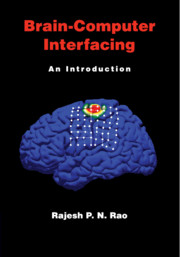Book contents
- Frontmatter
- Dedication
- Contents
- Preface
- 1 Introduction
- Part I Background
- Part II Putting It All Together
- Part III Major Types of BCIs
- 7 Invasive BCIs
- 8 Semi-Invasive BCIs
- 9 Noninvasive BCIs
- 10 BCIs that Stimulate
- 11 Bidirectional and Recurrent BCIs
- Part IV Applications and Ethics
- Appendix Mathematical Background
- References
- Index
- Plate Section
8 - Semi-Invasive BCIs
from Part III - Major Types of BCIs
Published online by Cambridge University Press: 05 October 2013
- Frontmatter
- Dedication
- Contents
- Preface
- 1 Introduction
- Part I Background
- Part II Putting It All Together
- Part III Major Types of BCIs
- 7 Invasive BCIs
- 8 Semi-Invasive BCIs
- 9 Noninvasive BCIs
- 10 BCIs that Stimulate
- 11 Bidirectional and Recurrent BCIs
- Part IV Applications and Ethics
- Appendix Mathematical Background
- References
- Index
- Plate Section
Summary
In the previous chapter, we learned about BCIs that required placing electrodes inside the brain. While such an approach provides a high-fidelity window into the spiking activity of neurons, it also comes with significant risks: (1) possible infections due to penetration of the blood-brain barrier, (2) encapsulation of electrodes by immunologically reactive tissue, which can degrade signal quality over time, and (3) the potential for damage to intact brain circuits during implantation.
To counter these risks, researchers have investigated the use of BCIs that do not penetrate the brain surface. Such BCIs can be regarded as semi-invasive BCIs. We will focus on two types of semi-invasive BCIs: electrocorticographic (ECoG) BCIs and BCIs based on recording from nerves outside the brain. As discussed in Chapter 3, ECoG requires surgical placement of electrodes underneath the skull, either under the dura mater (subdural ECoG) or outside the dura mater (epidural ECoG). The procedure is invasive but less so than the methods of the previous chapter. In this chapter, we explore the ability of ECoG BCIs to control cursors and prosthetic devices.
Information
- Type
- Chapter
- Information
- Brain-Computer InterfacingAn Introduction, pp. 149 - 176Publisher: Cambridge University PressPrint publication year: 2013
